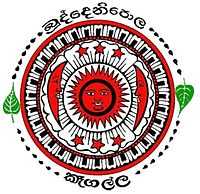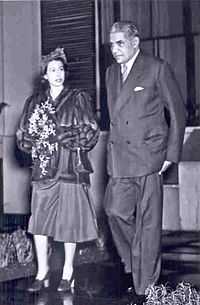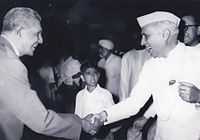Edwin Wijeyeratne
| Sir Edwin Wijeyeratne | |
|---|---|
 | |
| Cabinet Minister of Home Affairs and Rural Development | |
| In office 1948–1951 | |
| Member of the Senate of Ceylon | |
| Former Ceylonese High Commissioner to Britain and India | |
| Personal details | |
| Born | 8 January 1889 |
| Died | 19 October 1968 (aged 79) |
| Nationality | Ceylonese |
| Political party | United National Party |
| Spouse(s) | Lady Leela Wijeyeratne (née Pethiyagoda) |
| Children | Tissa, Nissanka, Manel, Cuda |
| Occupation | Politics and diplomat |
| Profession | Lawyer |
| Religion | Buddhist |
Sir Edwin Aloysius Perera Wijeyeratne, KBE (Sinhala:ශ්රිමත් එඩ්වින් ඇලෝසියස් පෙරේරා විජයරත්න;8 January 1889 – 19 October 1968) (known as Edwin Wijeyeratne) was a Sri Lankan politician, diplomat, and one of the founding members of United National Party. He was a Senator and Cabinet Minister of Home Affairs and Rural Development in the government of D.S.Senanayake.
Early days

Sir Edwin Wijeyeratne of Buddenipola Walauwa, Kegalle was born on 8 January 1889 in Rambukkana, Sri Lanka. He was the eldest son of Gabrial Perera Wijeyeratne, a respected notary public. The family hailed from the city of Kotte. His mother, Catherina Wickremasinghe Jayasekera Tennekoon, was the daughter of Jayasekera Tennekoon, a wealthy notary from the Four Korales in Kegalle. The family had come to Kegalle early in the 16th century, fleeing the Portuguese, and continued to intermarry with the Walauwes of Kotte, Madapatha and Matara.
Education
Wijeyeratne was first educated at the village school in Rambukkana. When nine years old, he went to Handessa Village School in Gampola, where he stayed at the home of his future wife, Leela Pethiyagoda. He was there for two years, after which he studied at St. Mary's College, Kegalle. He completed his secondary education at St Joseph's College, Colombo where he passed the Cambridge Senior exam with Honours. He won 15 prizes at the last school prize giving he attended.[1] After leaving school he became a teacher at Lorenz Tutory while working as a journalist. He served under one of the greatest editors Ceylon had hitherto, Armand de Souza, whom Governors feared and officials dreaded. Wijeyeratne subsequently successfully entered Law College and became a lawyer in 1929.

Queen Elizabeth II

Professional career
Edwin Wijeyeratne quickly built up a large legal practice. He was an expert in Civil and Kandyan Law, and in Buddhist Ecclesiastical Law. He entered the State Council in 1931 from Kegalle, where he served until 1936. He did not stand for re-election at the State Council in 1936, however he remained at the Bar from 1936 to 1947.
Political career
During his days in journalism, Wijeyeratne became political secretary to Sir Ponnambalam Ramanathan and was one of the co-founders of a political group, the Young Lanka League. He was a chief live wire in Ceylon's struggle for freedom, having been among the hundreds of Ceylonese arrested by the British colonial government during the Riots of 1915.[2] Others who faced imprisonment without charges included prominent figures of the independence movement such as FR Senanayake, DC Senanayake, DS Senanayake, Baron Jayatilaka, Dr CA Hewavitarne, WA de Silva, Arthur V Dias, John Silva, Piyadasa Sirisena and A E Goonesinha.
When the Ceylon National Congress was founded by Sir P Arunachalam and Sir James Peiris, Wijeyeratne was one of their colleagues and a co-founder. During British colonial rule, when the Lord Soulbury commissioners were on their way to Kandy, DS Senanayake had stationed Wijeyeratne bare bodied, in a paddy field in Kegalle.[1] There, he was introduced to the commissioners as a typical Sinhala farmer and who spoke in English to the commissioners and impressed on them the need for Ceylon to obtain self-government. A special invitation was then sent to Ceylon by Jawaharlal Nehru and the Indian Congress to visit India for a discussion regarding the independence of Ceylon. Wijeyeratne, DS Senanayake, George E De Silva, JR Jayawardene, Sir Claude Corea and HW Amarasuriya were among the delegates.
Wijeyeratne was appointed President of the Ceylon National Congress on 21 December 1940. His Joint Secretaries were Dudley Senanayake and JR Jayawardene. During this period he was chosen to lead the Ceylon National Congress delegation to London. In 1947 Wijeyeratne was appointed to the Senate which was a non-elected upper house of parliament. There he served as acting leader. He succeeded Sir Oliver Goonetilleke as Cabinet Minister of Home Affairs and Rural Development in DS Senanayake's government in July 1948. Wijeyeratne was a member of the Commission on the Death Penalty which first recommended the abolishing the death penalty from Ceylon in 1958.

While cabinet minister of Home Affairs and Rural Development, Wijeyeratne was appointed chairman of the select committee to select the National Anthem for Sri Lanka. Namo, Namo, Matha was subsequently selected as the country's national anthem.[3]
Diplomatic role
Wijeyeratne was appointed Ceylon High Commissioner to Britain in 1951. In 1953, he was made a Knight Commander of the Civil Division of the Order of the British Empire by Queen Elizabeth II at Buckingham Palace. As Ceylon High Commissioner, Wijeyeratne was involved in strengthening diplomatic relations between Britain and Sri Lanka. Wijeyeratne and his wife were visited at their residence in London on three occasions by Queen Elizabeth II and Prince Philip. In 1954, Wijeyeratne was appointed Ceylon High Commissioner to India. During this period he represented Ceylon at the coronation of the King of Nepal.
Family life
Wijeyeratne married Leela Pethiyagoda of Meewaladeniya Walauwa, Gampola and had three sons and a daughter. The eldest, Tissa Wijeyeratne was a Barrister at Law and served as the Additional Secretary to the Ministry of External Affairs and Defence, as Sri Lankan Ambassador to France and to Switzerland, and as Senior Advisor (Foreign Affairs) to Prime Minister Sirimavo Bandaranaike. Wijeyeratne's second son, Dr Nissanka Wijeyeratne, was former Cabinet Minister of Education, Higher Education and Justice and Diyawadana Nilame (Chief lay Custodian) of Temple of the Tooth. He had also been Sri Lankan Ambassador to the Russian Federation and former member of the governing body of UNESCO. The youngest son, Dr Cuda Wijeyeratne is a consultant psychiatrist.
See also
- List of political families in Sri Lanka
- Sri Lanka Matha
- Sri Lankan Non Career Diplomats
References
- J.R. Jayawardene of Sri Lanka: a political biography by De Silva, K. M., & Wriggins, W. H. 1988, University of Hawaii Press ISBN 0824811836
- The Break-up of Sri Lanka: the Sinhalese-Tamil conflict – Google Books Resultby Alfred Jeyaratnam Wilson – 1988 – History – 256 pages books.google.lk/books ISBN 1-85065-033-0... Chelvanayakam showed this writer a letter from one of Senanayake's close political collaborators, Edwin Aloysius Perera Wijeyeratne.
External links
- The Wijeyeratne Ancestry
- SORTING DIPLOMATS FROM THE OFFICERS. Daily News, Retrieved on 30 May 2013.
.jpg)